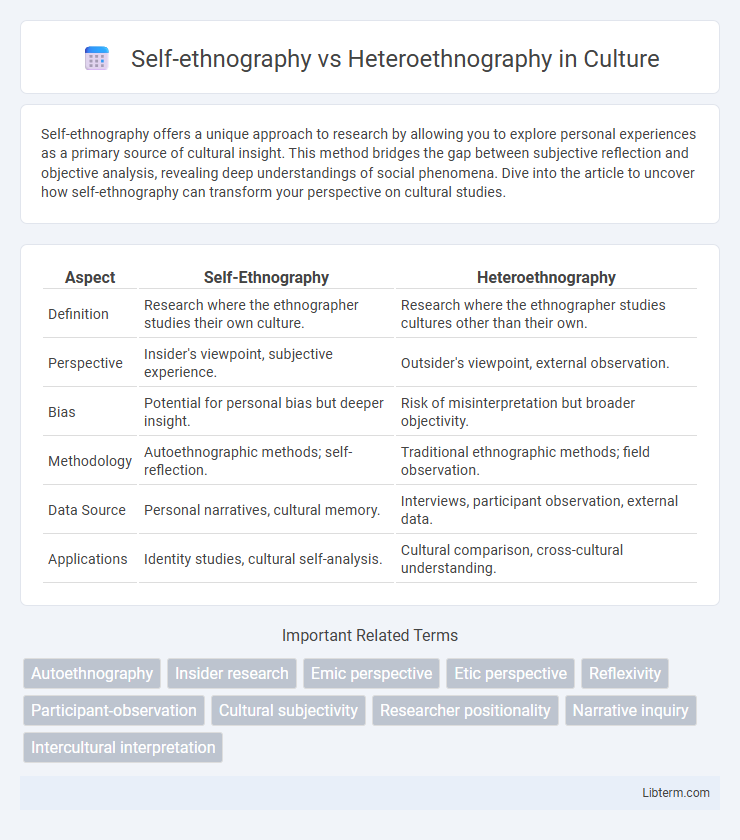Self-ethnography offers a unique approach to research by allowing you to explore personal experiences as a primary source of cultural insight. This method bridges the gap between subjective reflection and objective analysis, revealing deep understandings of social phenomena. Dive into the article to uncover how self-ethnography can transform your perspective on cultural studies.
Table of Comparison
| Aspect | Self-Ethnography | Heteroethnography |
|---|---|---|
| Definition | Research where the ethnographer studies their own culture. | Research where the ethnographer studies cultures other than their own. |
| Perspective | Insider's viewpoint, subjective experience. | Outsider's viewpoint, external observation. |
| Bias | Potential for personal bias but deeper insight. | Risk of misinterpretation but broader objectivity. |
| Methodology | Autoethnographic methods; self-reflection. | Traditional ethnographic methods; field observation. |
| Data Source | Personal narratives, cultural memory. | Interviews, participant observation, external data. |
| Applications | Identity studies, cultural self-analysis. | Cultural comparison, cross-cultural understanding. |
Definition and Scope of Self-ethnography
Self-ethnography refers to a qualitative research method where researchers use their personal experiences and introspection as primary data to analyze cultural and social phenomena. This approach focuses on the insider perspective, allowing for deep reflexivity and insight into one's own cultural context and identity. In contrast, heteroethnography involves studying cultures or groups external to the researcher's own, emphasizing observation and interpretation from an outsider's viewpoint.
Understanding Heteroethnography: An Overview
Heteroethnography involves the study of cultures or social groups external to the researcher's own experience, emphasizing objective observation and interpretation. It contrasts with self-ethnography, where researchers reflect on their own cultural practices and personal experiences within the studied context. Understanding heteroethnography requires recognizing its focus on cross-cultural analysis, the use of participant observation, and the aim to produce insights that transcend the researcher's subjective perspective.
Key Differences Between Self-ethnography and Heteroethnography
Self-ethnography involves researchers studying their own culture or community, providing insider perspectives and reflexive insights, whereas heteroethnography entails examining cultures or communities outside the researcher's own experience, emphasizing outsider observation and interpretation. Key differences include the positionality of the researcher, with self-ethnographers engaging in personal narrative and self-reflection, while heteroethnographers prioritize objective distance and external analysis. Methodological implications highlight how self-ethnography offers deep contextual understanding through lived experience, contrasting with heteroethnography's broader cultural comparisons guided by observational detachment.
Methodological Approaches in Self-ethnography
Self-ethnography involves the researcher studying their own cultural or social experiences, emphasizing reflexivity and personal narrative to uncover deeper insights into identity and context. Methodological approaches in self-ethnography prioritize autoethnographic tools such as journaling, personal storytelling, and introspective analysis to bridge subjective experience with broader cultural phenomena. This contrasts with heteroethnography, which employs observation and interviews of others to generate external cultural understanding without direct personal involvement.
Researcher Positionality in Heteroethnography
Researcher positionality in heteroethnography critically shapes the interpretation of cultural contexts, as the researcher studies cultures outside their own experience, requiring heightened reflexivity to address biases and power dynamics. This external standpoint demands rigorous awareness of how the researcher's identity, background, and assumptions influence data collection, analysis, and representation of the studied community. Effective heteroethnographic research integrates ongoing self-reflection and ethical considerations to authentically represent participants while minimizing misinterpretation rooted in outsider perspectives.
Ethical Considerations in Both Approaches
Self-ethnography emphasizes the researcher's reflexivity and insider perspective, raising ethical concerns related to privacy, consent, and potential bias since the researcher is also a participant. Heteroethnography involves studying others from an outsider viewpoint, which necessitates rigorous attention to informed consent, confidentiality, and respectful representation to avoid misinterpretation or exploitation of participants. Both approaches demand adherence to ethical research standards, with self-ethnography requiring heightened self-awareness and heteroethnography necessitating cultural sensitivity and transparency.
Strengths of Self-ethnographic Research
Self-ethnographic research enables deep introspection and rich contextual understanding by allowing researchers to analyze their own cultural experiences, enhancing authenticity and nuance in data. This approach facilitates access to insider perspectives and emotional depth, leading to a more comprehensive interpretation of social phenomena. The subjective nature of self-ethnography helps reveal subconscious biases and reflexivity, strengthening the validity of ethnographic insights.
Challenges and Limitations of Heteroethnography
Heteroethnography faces challenges such as researcher bias and limited cultural insight, as external observers may misinterpret behaviors or impose their own cultural frameworks. Language barriers and power dynamics often hinder authentic communication and participant trust, affecting data validity. These limitations can compromise the depth and accuracy of ethnographic findings, reducing the overall reliability of heteroethnographic research.
Practical Applications in Social Science Research
Self-ethnography offers profound insights into personal experiences, enabling researchers to examine social phenomena from an insider perspective, which is valuable in fields like psychology and cultural studies. Heteroethnography, involving the study of others' cultures and behaviors, supports comparative analysis and a broader understanding of social dynamics, crucial for anthropology and sociology research. Practical applications in social science leverage self-ethnography for in-depth narrative analysis, while heteroethnography facilitates cross-cultural validation and the identification of universal patterns.
Choosing the Suitable Ethnographic Method
Choosing between self-ethnography and heteroethnography hinges on research objectives and positionality; self-ethnography involves the researcher examining their own culture, providing rich, introspective data, while heteroethnography studies cultures external to the researcher, enabling broader cultural insights. Researchers must evaluate factors such as insider versus outsider perspective, potential biases, and ethical considerations to determine the most suitable ethnographic approach. The selection impacts data authenticity and analytical depth, influencing the overall validity of cultural interpretations.
Self-ethnography Infographic

 libterm.com
libterm.com